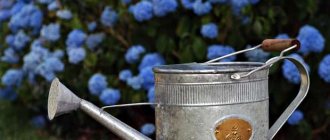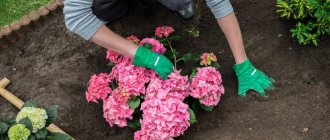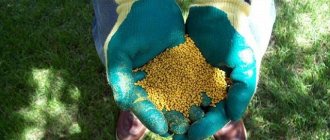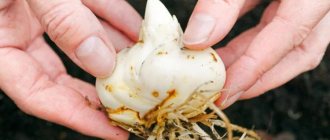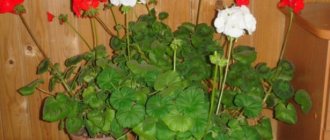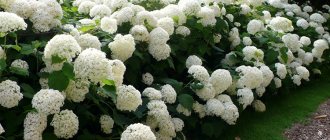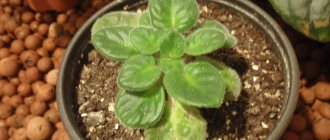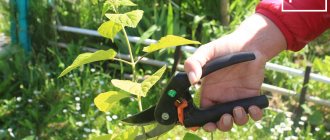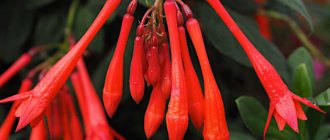Rhododendrons are a luxurious decoration for a garden plot; they are grown everywhere in different climatic conditions. Deciduous representatives of the flower culture are distinguished by their unpretentiousness to environmental factors and adapt well to new living conditions. With proper care and regular fertilizing, evergreen rosewood varieties can also surprise with their intense growth and impressive flowering.
The benefits of feeding and signs of nutritional deficiency
There are many varieties of rhododendrons. Some bloom for a short time, while others, with proper care and feeding, delight with lush color from mid-May.
In summer, plants especially need nutrients. Their presence promotes the active growth of green mass and the formation of buds. In spring, rhododendrons need nitrogen, in summer and autumn - phosphorus, potassium and sodium.
The use of complex formulations is allowed, but a greater effect is achieved when preparing nutrient mixtures from potassium nitrate, phosphate or sulfate, calcium sulfate, ammonium sulfate or magnesium. They have a mild acidifying effect and have a long-lasting effect.
Based on the characteristics of the soil and the specifics of feeding schemes, rhododendrons may experience a pronounced deficiency of a particular mineral or may develop a disease from an excess of nutrients.
Determining what elements plants lack is determined by their appearance and growth characteristics.
- A change in shade at the edges of leaf blades and loss of shine indicates a lack of potassium.
- A lack of nitrogen is expressed in the dull color of rhododendron foliage. The foliage begins to turn yellow in the spring.
- Slow growth of green mass and weak budding followed by fading of color indicate prolonged phosphorus and potassium starvation.
- Persistent yellowness of leaf blades with no response to fertilizing indicates an excess of aluminum ions in the soil. The problem is solved by watering the iron chelate solution.
The deficiency of mineral substances in the soil should be eliminated, regardless of the period in which the problem was discovered. Insufficient nutrition after the end of the decorative period of the bushes leads to the laying of a small number of flower stalks for the next season.
Feeding rhododendron in summer - step-by-step instructions for beginner gardeners
Rhododendrons are native to the Mediterranean region, where it is relatively cool and very humid. When growing in mid-latitudes, for successful cultivation it is necessary to create conditions close to natural. But despite this, many gardeners plant rhododendrons in their own gardens, because they bloom beautifully. For successful cultivation and abundant flowering, the gardener should know how to feed rhododendron in August.
Rules for feeding rhododendron
Complex mixtures are not suitable for rhododendrons as food. Fertilizers containing calcium are not used on rosewood. Also, do not use lime or wood ash, as these substances contain calcium and can reduce the acidity of the soil. An incorrectly selected fertilizer can cause chlorosis, deplete the bush and reduce its supporting forces.
Mineral supplements
Mineral fertilizing of rhododendrons in August should be carried out with special combined preparations that do not affect the acidity of the soil. It is advisable to purchase special fertilizers for azaleas of domestic production.
Manufacturers of imported compounds develop their fertilizers for warm climate varieties. In the southern regions, rhododendrons can be fertilized with your favorite compounds, since young branches have time to age by winter. In the northern regions this does not happen, which leads to the death of the bush. That is why it is recommended to use domestically produced mineral fertilizers. Imported fertilizers are used only in spring. In autumn, rhododendrons are fertilized with domestic food.
For autumn fertilizer of rhododendrons, sulfate, phosphate, potassium nitrate, superphosphate, calcium sulfate and ammonium are used.
The lack of mineral nutrition in the soil is determined by external signs:
- Chlorosis of leaf blades, which appears on a plant when cultivated on clay soil, is manifested by fading of color, stunting of growth, and a decrease in the splendor of flowering (if rhododendron does not bloom, read our article). For treatment, chelated forms of iron are used, for example, the drug Ferovit.
- Stunted growth indicates a lack of nutrition. The best preventative fertilizer for rhododendrons is Kemira. Some gardeners use RhodoAzalea AZ to create a balance of microelements in the soil.
When preparing mineral fertilizer yourself, you should mix 40 g of superphosphate and 20 g of ammonium sulfate, 20 g of potassium sulfate. Fertilizer is applied under each mature bush.
Organic Fertilizers for Rosewood
Under no circumstances should chicken droppings or fresh manure be placed under rose bushes. When using mullein, rotted fertilizer is used. Mullein is scattered over the snow and with the first melting, the food enters the soil in a diluted form.
Organics are best used in the form of solutions. That is why mullein is diluted with water in a ratio of 1 to 20. The mixture is infused in a dark place for 7-10 days, filtered and watered at the root. It is advisable to apply fertilizers to moist soil at a distance of 25 cm from the shoots.
Horny shavings can be used to fertilize rhododendrons. This substance consists of phosphorus and nitrogen. The drug is used for spring-summer feeding, and therefore is not suitable when determining what to feed rhododendron in the fall. But during the active growing season, horn flour promotes the formation of young shoots and helps the plant develop faster. Fertilizer for rhododendrons is applied directly under the root in dry form.
Recommendations from experts
Rhododendrons are very demanding to care for. For good health and lush flowering of plants, it is important to follow a number of rules for care and feeding.
- Choice of fertilizers. It is recommended to feed young bushes with fertilizers in liquid form. Solutions are better absorbed by the root system.
- Manufacturer's choice. Experts do not recommend using imported granular fertilizers. They contain nutrients designed for plant varieties growing in other climates. The use of imported compounds often leads to the fact that rhododendron will begin to grow shoots in August and will not have time to prepare for frost.
- Wood ash. The use of ash leads to changes in soil acidity and the occurrence of chlorosis in plants.
- Excess phosphorus. Excessive phosphorus content in the soil leads to poor absorption of iron. As a result of its deficiency, plants develop chlorosis. Young seedlings are most susceptible to the disease.
In addition to general tips, it is important to know the most common mistakes that gardeners encounter and their consequences.
- Nutrient overdose. Rhododendrons do not respond well to over-fertilization. As a result of “overfeeding,” the flower mass decreases and diseases occur. If the situation is not corrected, the bush may die.
- Wrong choice of fertilizers. The use of fertilizers that reduce soil acidity has a negative effect on the development of bushes. The condition of rhododendrons is also negatively affected by the application of fertilizers containing inappropriate proportions of microelements.
- Spraying. During the flowering period, it is not recommended to spray the bushes. It leads to darkening of flower stalks and shedding of buds.
- Feeding during the flowering period. During the flowering period, the bushes are not fed. Fertilizing during this period leads to the dropping of flowers.
- Choosing the time and weather conditions for fertilizing. It is not recommended to fertilize plants in hot or dry weather. The scorching sun in combination with fertilizing leads to burns of young stems and leaf blades.
Feeding should be done in the morning or evening. It is optimal to choose days before rain.
Knowledge of the intricacies of organizing the nutrition of evergreen shrubs allows you to achieve maximum decorativeness from them.
What happens if you stop fertilizing rhododendron?
The answer to this question is quite simple. At first, rhododendron develops on soil that contains mineral elements. It blooms beautifully and emits a pleasant aroma. Then they stop fertilizing the soil. Nutrients are gradually depleted. Soil acidity decreases. The plant loses its decorative appearance, gets sick and, in the worst case scenario, dies.
The beauty of flowering is a reward
Thus, flower beds in gardens are designed to delight and create spiritual harmony. But it takes work to achieve this. When growing rhododendrons, gardeners must take into account the needs of the plant and its whims. Only then will it give them its bright flowering, splendor, and aroma.
Site selection and soil preparation
Rhododendrons prefer fertile, loose soils with high acidity and good oxygen penetration. If you plant a plant in an alkaline environment, the seedling will not survive or will often get sick and develop poorly.
The best combination for planting is a mixture of peat with coniferous decline and leaf soil, taken in a ratio of 2:1:3. Another successful combination is a mixture of peat and pine sludge in equal quantities.
Thanks to the introduction of sphagnum moss, ammonium, potassium sulfate and other types of acidic fertilizers, specialists maintain the necessary soil environment.
When planting bushes for the first time, the soil requires preliminary preparation. The site is dug up with heather soil, garden soil and river sand, taken in equal parts. For fertility and maintaining the desired pH, mullein, droppings, and pine pulp are added. The components are used in equal proportions. For additional feeding, the drug Kemira Universal is applied.
On clay soil, add a drainage cushion under rhododendrons. In the case of close proximity to groundwater, artificial hills are arranged for plants. This allows you to avoid flooding in March-April.
Features of the root system. What tuks cannot be used?
A feature of the root system is the presence of mycorrhiza, a fungus that helps the plant grow and develop in acidic soils limited in the amount of mineral nutrients (this is the soil in which the bush likes to grow). Without mycorrhiza, seed germination is also impossible, but it is it that determines the basic conditions for fertilizing and feeding. Fertilizer solutions should not contain chlorine-containing elements, since such fertilizer will kill the mushrooms. When growing shrubs, you should check the acidity of the soil in the spring. If the pH value (pH) is in the range of 4.5–5.5 units, then the diet should be changed using more acidic fertilizers.
Important! Lime and dolomite flour are fertilizers that can alkalize the soil. Fertilizing with these nutrient solutions is not recommended due to a decrease in soil acidity. The result may be the appearance of yellow spots on the leaves.
Another feature is the compact root system, so when planting the plant it is recommended to lay a good drainage layer with loose soil and nutrient-rich fertilizers.
If during the first year of life the rhododendron actively grows and develops due to proper planting, then in subsequent years it requires mandatory replenishment, since the reserves of nutrients in the soil are gradually depleted and the acidity level decreases. Due to the lack of fertilization, the plant may not produce flower buds or die.
Types of fertilizers
Fertilizers for rhododendrons are chosen mineral or organic, which help reduce soil acidity. Nitrogen promotes the active growth of green mass, phosphorus and potassium are responsible for the formation of inflorescences.
Mineral complexes
Mineral complexes are presented in a wide range. Their advantage lies in their ease of use and the ability to add specific elements depending on the needs of the plants.
Modern mineral compositions include elements for soil acidification. This eliminates the need for gardeners to take additional measures to maintain soil pH.
Mineral complexes are used only according to the instructions and the recommended application schedule. Overfeeding plants can lead to their death.
Of the mineral compositions, the following showed high efficiency:
- Iron chelate (effective on clay soils);
- Nitrogen-containing compounds;
- Potassium sulfate, magnesium, ammonium (they acidify the soil well).
Rhododendrons respond well to feeding with potassium sulfate, calcium, magnesium and ammonium. Experts also use potassium nitrate, potassium phosphate and superphosphate. Effective feeding methods include a solution of potassium and phosphorus. For preparation, 8 grams of potassium phosphate and potassium nitrate are taken per 10 liters of water. Of the ready-made complex formulations, Kemira-M has performed well.
Organic compounds
In fertile, well-drained areas, you can do without applying mineral fertilizers. Organic matter is suitable for feeding. The best option is to mulch the tree trunk circle. The thickness of the surface layer is up to 8 centimeters. This method allows you not only to maintain the desired pH of the soil, add nutrients, but also to prevent the germination of weeds.
For mulching, use materials taken only from healthy trees.
- Pine needles. Shredded pine needles are the best option for mulching. It is taken or purchased in pine nurseries.
- Bark of gymnosperms. The best option is pine bark. To prepare the shavings, use fresh bark, crushed on a special grinder.
- Peat crumbs, grass, foliage. These materials are also used to mulch bushes. When using foliage and grass, it is important to ensure that it is not taken from diseased trees and that it is free of pests.
When decomposed, mulch releases the entire range of nutrients to the soil and serves as a good acidifier. But its effect is limited in time. It is recommended to change the mulch layer every 2-3 months.
If manure or slurry with the addition of superphosphate is used, then it is necessary to additionally check the acidity of the soil and promptly apply pH-lowering preparations.
Among organic materials, horn waste is highly valued. They contain large amounts of phosphorus and nitrogen.
Rhododendron
The plant belongs to the Heather family and enjoys great success among gardeners due to its beautiful foliage and abundant flowering. The inflorescences of some varieties of the crop have a delicate aroma. The leaves are spiral-shaped; depending on the species, the size of the flowers in the inflorescence varies in the range of up to 5 cm or more.
Rhododendron has a compact root system. Due to the absence of root hairs, the basis of nutrition for the shrub is the mycorrhiza mycelium - the simplest fungi. For the normal functioning of the mycelium, constant air circulation is necessary, so dense soils are contraindicated for the plant. Its natural habitat is undergrowth with a special microclimate, where rhododendron is protected by trees from winds, scorching rays of the sun, and seasonal temperature fluctuations.
Rhododendron prefers light shade. For planting, you need to choose a place where there is a sufficient level of illumination in the morning and in the evening. At the same time, the plant does not tolerate direct midday rays and suffers from exposure to the scorching sun. It is optimal for its cultivation in the vicinity of trees, in the shade of which the bush is provided with diffused light. The culture also needs protection from the winds.
Important! In order for rhododendron to delight with its luxurious appearance and abundant flowering, it is necessary to create conditions for its natural habitat.
At the same time, regular feeding should not be neglected, since a green pet needs timely replenishment with useful substances.
With a deficiency of useful elements necessary for development, rhododendron leaves lose their color intensity and shine, turn yellow and dry out. Lightening of the foliage and falling off is an alarming signal about the depletion of the green pet. Poor shoot development also indicates a lack of nutrition. In the absence of a sufficient level of soil fertility with a deficiency of fertilizer, the “rose tree” will not only wilt and not bloom, but may also die.
Fertilizers stimulating growth and flowering
Stimulants are a separate category. These drugs are not direct supplements.
- Zircon. The drug promotes rapid adaptation to a new place.
- Epin. The drug is used for spraying plants. Is a good anti-stress drug for rhododendrons
- Ecogel anti-stress. The product is supplied in liquid form. It is highly efficient.
- Ferovit. The drug is used for the development of chlorosis.
- Emerald. Recommended for use on brown and faded foliage. Promotes the growth of green mass.
- Fitosporin-M. The drug is aimed at building immunity to diseases. Helps prevent rotting of the root system.
Thanks to growth and flowering stimulants, young plants quickly take root in a new place and produce lush flowers in the first year.
How to feed rhododendron in spring and summer?
Rhododendron is a member of the heather family, with delicate spherical flowers. This is a slow-growing flower with a shallow root system, so it is important to drain the soil regularly, otherwise water and nutrients will not reach the roots in full. The plant loves to be fertilized. In return, he always thanks with his bright, beautiful buds. This article is about how to feed rhododendron in the spring for flowering, after flowering and in the summer for laying buds for next year.
Feeding at different stages of growth
At different stages of development, rhododendrons require different fertilizers. Plants are fed up to 3-4 times. Specialists actively use organics and mineral complexes.
The first fertilizing is applied in the spring. At the beginning of the season, it is recommended to use nitrogen-containing organic matter or mineral fertilizers. The best option is mullein with high-moor peat. The manure must first be rotted. This composition is used instead of mulch. Rhododendrons are also responsive to mullein solution. To prepare it, take 15 parts of water for 1 part of mullein and leave to steep for several days. To feed an adult bush, 10 liters of solution are required.
Of the mineral compositions at the stage of laying buds, Azofoska is suitable. It contains nitrogen, phosphorus and potassium in a ratio of 22:11:11. The drug is supplied in the form of granules.
The next application occurs after flowering. The time is approaching the end of May or the beginning of June. Feeding is aimed at laying new buds. During this period, the complex drug Kemira, Universal or nitrogen-containing compounds help well. From organic matter - high-moor peat.
The third feeding is done in mid or late July. Use formulations with phosphorus and potassium.
Final feeding of rhododendrons is carried out in the fall. It is necessary to prepare the bushes for wintering. In September, 1% potassium sulfate is used to treat the crown. He prevents the bushes from running again. In late autumn, a phosphorus-potassium complex is introduced. Before the snow falls, the bushes are covered. It will protect the plants from severe frosts.
Top dressing
Twice a year: at the end of flowering and at the beginning of July, it is necessary to feed rhododendrons with mixtures of mineral fertilizers (“Kemira for rhododendrons” or “Kemira-universal”). For liquid feeding, 20 g of fertilizer is dissolved in 10 liters of water. You can simply scatter it dry around the bushes at the rate of 100 g per 1 m².
Very good results are obtained by using a mixture of acidic fertilizers: ammonium sulfate, superphosphate, potassium sulfate and magnesium sulfate in a ratio of 9:10:4:2. It is best to apply this mixture in three stages:
- per 1 m², apply 100 g in early spring, during the period of bud swelling;
- another 100 g of the mixture is added at the end of flowering;
- another 50 g of the mixture is added at the beginning of July (during the beginning of secondary shoot growth).
For lush flowering, rhododendrons need to be fed
Rhododendrons also require organic fertilizers. It is best to use acidic high peat
If it is not available, you can use albumin or rotted manure, but use it very carefully, in small quantities and only in spring or early summer. Under no circumstances should fresh manure be used! 0.5 liters of fermented slurry is diluted in a bucket of water and used to water 4 m²
Microelements are needed in very small quantities. If the substrate contains leaf soil and pine needles, then they contain a sufficient amount of microelements. If the substrate has a different composition, you can use “AVA” fertilizer.
Rules for soil acidification
Rhododendrons actively develop in acidic soil. For this reason, it is important to check the pH and periodically acidify the soil. The optimal value is from 3.5 to 5.5. If ammonium sulfate in combination with potassium nitrate or a mixture of urea and potassium magnesium are used as fertilizers, the soil will be quite acidic. This rule is also equivalent for bushes, the root circle of which is covered with regularly renewed pine needles.
In spring and the first half of June, the soil does not need to be acidified. Everything you need comes with nutritional formulas. In the second half of June and beyond, fertilizing plants with nitrogen stops. Therefore, there is a need to acidify the soil.
- Vinegar. Watering plants with a vinegar solution can be done at any time. The procedure is necessary only for acidification. The main disadvantage of the method is that the soil loses quality and plants develop diseases.
- Lemon acid. Lemongrass is also not one of the most beneficial methods for soil acidification for plants. Its main advantage is accessibility. For the solution, use 10 liters of water and a teaspoon of lemon.
- Coniferous litter. Pine needles are best suited. The collected material is scattered around the root circle of the bush, changing periodically.
- Sphagnum peat. Peat gives a good result in acidifying the soil. It is used in a similar way to mulch. A layer of peat from 5 to centimeters is sprinkled into the tree trunk circle.
Knowing the intricacies of feeding and following the rules of caring for rhododendrons allows you to achieve a luxurious appearance of plants throughout the season.
Feeding rhododendrons in August: types of fertilizers, plant care
Heat-loving and delicate rhododendrons or rose trees, whose homeland is the Mediterranean, in mid-latitudes require more careful care and adherence to agricultural practices.
Flowers in the form of bells, collected in inflorescences from 3 to 10 pieces in one, spread the aroma during flowering. The flowering period is not long: only 2 - 3 weeks in spring. In favorable conditions, the shrub grows up to 2 meters, but more often the plant height does not exceed a meter.
Conditions for growing rosewood
Rhododendrons love acidic soils, but grow well in slightly acidic ones. They do not like wind, scorching rays of the sun and drafts. Therefore, before planting rhododendron, you need to evaluate your site in terms of soil pH and the presence of large trees in the shade of which the pink tree can be hidden. It is also desirable that the bush be closed on the north side by a wall, so the most favorable place is near the fence or behind the house.
Stagnant water has a bad effect on the roots and, as a result, on the quality of flowering. If there is a hill near the house, this place should be suitable for rhododendron.
Landing
For a seedling purchased in a store, a hole up to 1 meter deep and 60 cm wide is prepared. This is necessary in order to add a substrate for feeding the rhododendron, which consists of humus, peat and pine needles.
The root system should fit freely in the hole. The soil in the pot must first be soaked and left for an hour so that the tree receives the necessary moisture. For better survival, stimulants are added so that the plant can better tolerate transplantation. We must not forget that this tree takes root with difficulty, so it is better to be on the safe side.
The rose tree is transplanted to the same depth at which the root collar was located in the purchased container. After sprinkling with earth, the area is well watered and mulched to retain moisture. Coniferous litter or bark is suitable for this purpose.
It is better to plant in spring or in the first half of summer, so that the shrub has time to take root and new shoots become lignified by the onset of autumn. If you replant later, then starting in August, reduce abundant watering so that new branches do not grow, otherwise they will freeze before they have time to become covered with tree bark.
For planting, choose two-year or three-year-old bushes. Before purchasing, inspect the root system: it should not have any foreign inclusions, swelling, or wet areas. The leaves should be dark green, without spots.
The most vulnerable place of a rhododendron is its root system. It is located in the upper layers of the soil and cannot obtain water and nutrients from deep horizons. Therefore, around the tree it is necessary to periodically remove weeds, which take away the nutrition from the plant, as well as the water it needs. Loosening is carried out carefully so as not to damage the roots.
Due to the high acidity of the soil, which is a necessary condition for growth, the plant may become deficient in iron or manganese. For this purpose, special solutions of microelements are used to feed rhododendron. Important: solutions should not contain calcium, otherwise the pH of the soil will increase and the plant will wither.
Rhododendron needs winter shelter, as it does not tolerate frost well. Even the most cold-resistant varieties are covered with special material. In front of the shelter, you need to build a frame of boards so that the branches do not break under the weight of the snow.
Rules for feeding rhododendron
Any fertilizer for rhododendrons - mineral or organic, containing calcium - is not suitable for rosewood. You cannot lime the soil and use ash, since the ash solution contains calcium in large quantities. Rhododendron leaves may begin to turn yellow due to chlorosis.
Mineral supplements
It is better to use special mixtures of mineral fertilizers to maintain the required soil acidity. Such mixtures are sold in gardening stores or supermarkets. Flower lovers who have been growing rhododendrons for a long time have noticed that it is better not to use imported mixtures, since they are designed for plants cultivated in warm climates.
In the southern regions, the growth of new shoots is not a problem, since the rosewood does not experience temperature changes. In the middle zone, when foreign mineral fertilizers are used, rhododendrons begin to actively grow branches, which do not have time to become covered with protective bark and freeze out in winter.
Products on the market
There are a great variety of products on the market for feeding rhododendrons. When choosing the optimal fertilizer, you should focus on what problems the plants have and what final result needs to be achieved by using this or that drug.
Pokon
A universal fertilizer made in Holland that promotes regular, abundant and long-lasting flowering of rhododendrons, as well as maximum preservation of their health. The product is well absorbed by plants and can be used year-round. During the active growing season, the composition is diluted according to the instructions (at the rate of 10 ml of the drug per 1 liter of water); in winter, for home or greenhouse varieties, the dosage is halved.
Bona forte
Russian complex fertilizer for rhododendrons is used to increase their decorative properties, stimulate growth and provide adequate nutrition. When growing shrubs, it is recommended to combine root feeding and spraying with Bona Forte. To water the plants, the drug is diluted in water at the rate of 10 ml per 1.5 liters of liquid, sprayed with a solution containing half the dose of the product.
Manure
Cow manure is used as fertilizer for rhododendrons only in semi-rotted form. Fertilizing is carried out in spring or summer, carefully monitoring the level of soil acidity and preventing it from decreasing.
Pig and horse manure are absolutely not suitable for fertilizing rhododendrons, as they contribute to alkalization of the soil.
Preparations containing compressed manure can be easily found in gardening stores.
